|
|
SpaceX announced Monday afternoon (in a press release that, curiously, was not on their web site as of late Tuesday morning) that they have received a commercial spacecraft reentry license from the FAA’s Office of Commercial Space Transportation (AST), the first since license issued by that office:
Next month, SpaceX is planning to launch its Dragon spacecraft into low-Earth orbit atop a Falcon 9 rocket. The Dragon capsule is expected to orbit the Earth at speeds greater than 17,000 miles per hour, reenter the Earth’s atmosphere, and land in the Pacific Ocean a few hours later.
This will be the first attempt by a commercial company to recover a spacecraft reentering from low-Earth orbit. It is a feat performed by only 6 nations or governmental agencies: the United States, Russia, China, Japan, India, and the European Space Agency.
That launch, scheduled for no earlier than December 7, is the first of three Commercial Orbital Transportation Services (COTS) demonstration missions, part of the company’s $278-million COTS award from NASA in 2007. The receipt of the license also generated a congratulatory statement from NASA, which is depending on SpaceX and Orbital Sciences, the other COTS awardee, to provide transport of cargo to (and in the case of SpaceX, from) the ISS.
The SpaceX license award came the same afternoon that Mojave-based Masten Space Systems announced signing a letter of intent with Space Florida that could lead to suborbital demonstration flights from Cape Canaveral in 2011. Masten would fly from Launch Complex 36, a former Atlas launch site that is now operated by Space Florida. According to a Florida Today report, Masten would fly a prototype of its planned future suborbital vehicle from the Cape, flying to altitudes of about 30 kilometers.
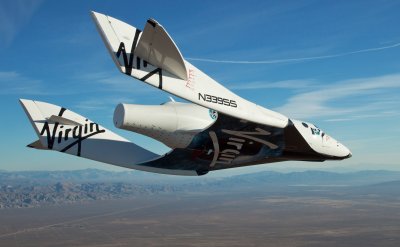 SpaceShipTwo during its first glide test on October 10, 2010. (credit: Mark Greenberg/Virgin Galactic) Scaled Composites carried out a third glide test flight of SpaceShipTwo (SS2) on Wednesday. According to the company’s WK2/SS2 flight test logs, SS2 flew free for 11 minutes and 39 seconds after its release from WhiteKnightTwo. There were no major milestones reported for the test, and all test objectives were achieved, according to the log. Those objectives included flying to “a more aggressive stall indication” and a slightly higher airspeed and g-forces.
Last week a Florida nonprofit, the Aerospace Research and Engineering Systems (ARES) Institute, announced a competition titled “Win A Trip To Space!”. The idea was simple: buy a raffle ticket, and one lucky winner will get a ticket on a suborbital spaceflight. But the contest rules appear to have quietly changed since last week’s announcement, perhaps to ensure that they comply with state law.
“In support of its mission to broaden public awareness of the benefits of space exploration, the Aerospace Research & Engineering Systems Institute, Inc. is giving the public the opportunity to take the ride of a lifetime to the edge of space! We have established an innovative contest giving any U.S. citizen age 18 or older the chance to purchase tickets at $10 a piece to be placed into a raffle,” read the opening paragraph of the ARES Institute press release, emailed late Friday by the organization’s executive director, Matthew Travis. Later, the press release notes: “The contest will end when either the required number of tickets have been sold to cover the prize costs or on December 31, 2012, whichever comes later. This ensures that sufficient funds are raised for the spaceflight and that everyone will have an adequate opportunity to purchase tickets.”
Both the explicit charge for the tickets and the requirement that a certain number be sold, though, appeared to run afoul of Florida law. Section 849.0935 of the Florida Statues does allow nonprofits like the ARES Institute to carry out “drawings by chance” like this one, but with several conditions. One of them is that it is unlawful to “require an entry fee, donation, substantial consideration, payment, proof of purchase, or contribution as a condition of entering the drawing or of being selected to win a prize.” (It does go on to state that organizations are allowed to suggest a minimum donation.) It’s also unlawful to “condition the drawing on a minimum number of tickets having been disbursed to contributors or on a minimum amount of contributions having been received”.
The current rules make no mention of an entrance fee or a number of tickets sold. “No purchase is necessary to enter the drawing, but donations are accepted and encouraged,” the rules now state. A $10 donation, for example, will get you an entry as well as a DVD and a six-month subscription to access portions of the Spaceflight News web site, valued at about $40. The rules now also explicitly state, “There is no maximum number of tickets that may be issued.” (There’s no mention of a minimum number, either.)
That’s a change from the old rules, a screenshot of the cached version of which is below. “The price of a ticket is $10,” the rules state, with 20% of the cost going to the ARES Institute for overhead costs associated with the competition and to support the organization’s other activities. The next rule states: “A minimum of 30,000 tickets will be sold before a winner is selected.” And the following rule: “Contest deadline is either when 30,000 tickets are sold or midnight, December 31, 2012, whichever occurs last. Under no circumstances will fewer tickets be sold than are required to award the prize unless the contest must be terminated for reasons beyond the control of ARES Institute.”
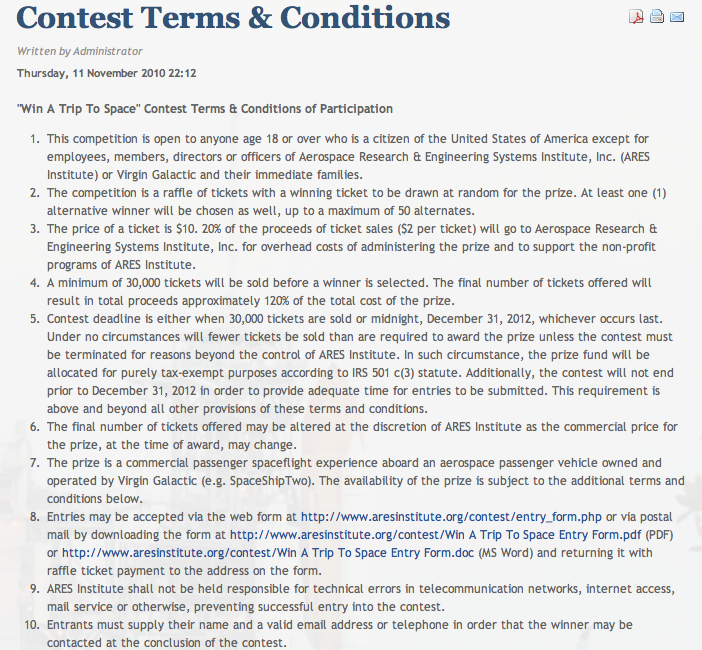 A screenshot of the original competition rules, as they appeared on the ARES Institute's web site on November 13. ARES Institute made no announcement about the changes, or why they were made. Over the weekend I emailed Mr. Travis asking him a couple of questions about the competition, including that state law appeared to prohibit a mandatory charge on entries. I received no response from him, but by Wednesday morning at the latest the updated rules had been posted. (There’s no evidence, though, that my inquiry led to the rules change, only that I never heard back from the organization and only later found that they had since changed the rules.)
There’s one other change in the new rules worth noting. The current rules mention only that the winner will get “a commercial passenger spaceflight experience on a passenger aerospace vehicle supplied by commercial provider”, generically referred to in the rules as a “Spaceflight Provider”. The older version of the rules, though, specifically mentioned Virgin Galactic as the spaceflight provider (“a commercial passenger spaceflight experience aboard an aerospace passenger vehicle owned and operated by Virgin Galactic (e.g. SpaceShipTwo).”) Other elements of the original rules prohibited Virgin Galactic employees and their families from participating, and also noted that “Virgin Galactic is the sole operator of the spaceflight and has sole discretion over legal and contractual obligations between Virgin Galactic and the prize winning participant.” While those rules also noted that the ARES Institute is not affiliated with Virgin, it appears that either the organization is hedging its bets about availability of suborbital spaceflight operators or was asked not to explicitly identify Virgin in the rules.
Robin Snelson recently posted on Ustream a video press release from the legendary Rocket Rocket Company, an entrepreneurial RLV developer from the late 1990s:
The 15-minute video from 1998 starts with an animation of the unique flight profile of the company’s Roton SSTO RLV: launch vertically into orbit, deploy its payload, then land vertically using helicopter-like rotors. It then follows with interviews with a number of company officials, many of whom read like a who’s who of NewSpace today: in addition to Rotary founders Gary Hudson and Bevin McKinney, there are cameos by Jeff Greason and Dan DeLong, who went on to found XCOR Aerospace; Burt Rutan of Scaled Composites; and Brian Binnie, a test pilot for Rotary who later flew SpaceShipOne for Scaled.
The video apparently predates the 1999 rollout of the Roton Atmospheric Test Vehicle (ATV) at Mojave Airport. The ATV made a few low-level flight tests using its rotors (powered by tip thrusters), but the company’s financial problems prevented additional test flights as well as the development of additional prototypes. The ATV was destined to go to a helicopter museum near San Diego, but an attempt to airlift the ATV by a Chinook failed. Instead, the ATV is now installed in a small park by the Mojave Air and Space Port headquarters:
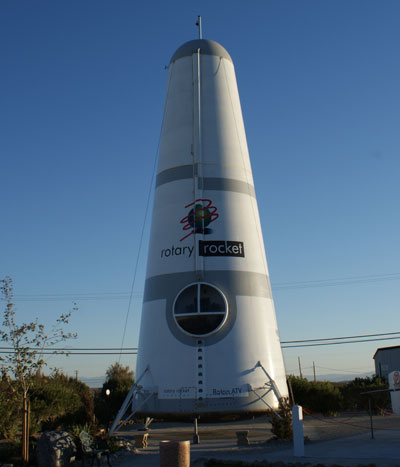
SpaceX has raised another round of financing, to the tune of $50 million, according to an SEC filing by the company on Tuesday. A company spokesman told Business Insider that the additional funding came from existing investors, which would include the Founders Fund and Draper Fisher Jurvetson. However, there appears to be a new (or at least significantly increased) investor in the company: Valor Equity Partners. Valor CEO Antonio Gracias is now listed as a director of SpaceX (he was not listed in SpaceX’s previous SEC filing in March 2009) and SpaceX is now listed in Valor’s online portfolio. (Valor is also an investor in another Elon Musk company, Tesla Motors.)
Special Aerospace Services, a Colorado aerospace company, announced Monday they would host the first Commercial Human Spaceflight Technical Forum in Boulder this coming January. The one-and-a-half-day conference is designed to give attendees “insight to techniques that will be required to successfully achieve NASA human rating certification and FAA commercial spaceflight licensing”, according to the conference web site. Featured speakers include former shuttle program manager Wayne Hale and former astronaut Jeffrey Ashby.
Groundbreaking is scheduled for Tuesday in Mojave for a new production facility for WhiteKnightTwo and SpaceShipTwo. The 68,000-square-foot (6,300-square-meter) factory for The Spaceship Company (a joint venture of Virgin Galactic and Scaled Composites) is slated for completion in September 2011. The formal name of the facility, according to a Tehachapi News article, is the Final Assembly, Integration and Test Hangar, which, yes, has the acronym FAITH.
SpaceX has rescheduled its next Falcon 9 launch for no earlier than December 7, citing both delays of other launches at Cape Canaveral as well as a desire to run more tests. The launch will be the first of three planned test flights of the Dragon spacecraft under its COTS agreement with NASA. The delay will also give SpaceX additional time to secure a first-ever reentry license for the Dragon from the FAA.
Some people dream their whole lives about flying in space. For Marc and Sharon Hagle, they sort of stumbled across the opportunity, the Orlando Sentinel reports. The two were taking a Zero-G flight along with, as it turned out, a number of Virgin Galactic sales agents, and as the article notes, “It didn’t take much to sell the Hagles on the chance for some real space travel.”
The first SpaceShipTwo vehicle, VSS Enterprise, performed a glide test this morning in the skies above the Mojave Air and Space Port in California, according to observers as well as Virgin Galactic. No details about the flight test, other than that it was successful, have been released, although when more details are available they’ll likely be included in the SS2 flight log at Scaled.
Update: the log has been updated, noting that all test objectives were achieved. Highlights include: “Flew to more aggressive stall indication. Evaluated handling and stability through several maneuvers.”
These are all photos I took of Friday’s event, including the people, facilities, and, of course, WhiteKnightTwo and SpaceShipTwo.
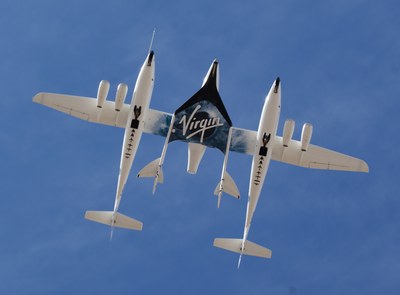 WhiteKnightTwo and SpaceShipTwo soar above the crowd at Spaceport America on Friday. (credit: J. Foust) Friday’s events at Spaceport America went off pretty much as planned. There were the speeches by dignitaries (including Richard Branson, New Mexico Gov. Bill Richardson, and NASA deputy administrator Lori Garver), followed by the flyover by WhiteKnightTwo with SpaceShipTwo attached. After the two vehicles completed several passes and appeared to fly off, Branson and the others started a press conference.
However, a short time into the press conference Branson interrupted the Q&A. “I rang the pilot of the spaceship and said, ‘Look, we’ve got a runway here. Why are you going back to Mojave? Why can’t you come and sort of show it off?’ I’m not sure I managed to persuade him, but maybe we could all sort of put some vibes up in the sky.” What followed was the odd spectacle of several hundred people shaking their hands, clapping, and stomping their feet, all at the insistence of Branson, to try and get WK2 and SS2 to return.
“What’s the point of having a spaceport if you don’t land at a spaceport?” Branson asked. The first time around this didn’t get the vehicles to return, but several minutes later he interrupted the press conference again to get people to do the same thing. And this time, it “worked”: WK2 and SS2 reappeared in the skies over the spaceport and landed on the runway, which during the ceremony had been renamed the Bill Richardson Spaceway. The vehicles became the backdrop for photo opportunities and the like for the remainder of the event.
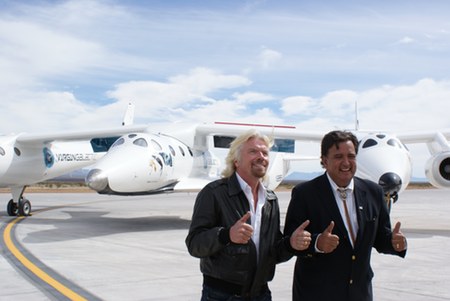 Sir Richard Branson and New Mexico Gov. Bill Richardson pose in front of WhiteKnightTwo and SpaceShipTwo at Spaceport America. (credit: J. Foust) Besides the unexpected (albeit rumored in the days leading up to the event) landing, there were only a few other announcements or other newsworthy items at the event. In his speech Virgin Galatic CEO George Whitesides announced a new program called “Galactic Unite”, an initiative designed to support STEM (science, technology, engineering, and mathematics) education. That program is being done in cooperation with Virgin Unite, the Virgin Group’s non-profit arm, and the New Mexico Space Grant Consortium.
Virgin officials did not talk too much about other aspects of the spaceport or vehicle development. “We saw the latest successful major test fire of our rocket motor” being developed by Scaled Composites and Sierra Nevada Corporation, Whitesides said, but didn’t mention when that test took place other than the test is “moving us well along the way to an ambitious upcoming test schedule.” Later, Virgin Galactic president Will Whitehorn said that for the hybrid rocket motor they were looking at replacing the rubber used as the solid fuel with “basically recycled nylon” that would have a lower carbon output than the conventional motor. It wasn’t clear from those statements what fuel they’re using for the rocket motor in the current tests (I was next up to ask a question along those lines when Branson interrupted again just before the return of WK2 and SS2.)
Also during the press conference Branson was asked about orbital vehicle development. That is a long-term goal of the company, but Branson suggested they would try to find ways to accelerate it. “Obviously we want to move on to orbital after we’ve got suborbital under our belts, and maybe even before that,” he said, then mentioned NASA’s commercial crew development program and its request for proposals in the coming months. “Virgin Galactic is going to put forward proposals, and we plan to start work on an orbital program quite quickly.” Branson declined to provide any details on Virgin’s orbital vehicle plans, but said the company would say more in the next three to four months.
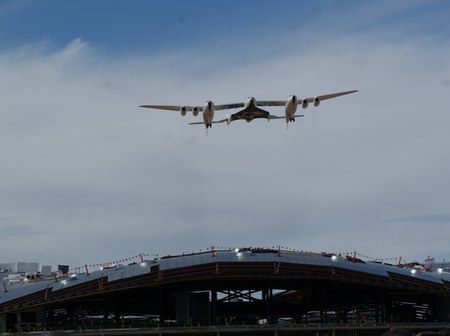 WhiteKnightTwo and SpaceShipTwo fly over the Terminal Hangar Facility under construction at Spaceport America. (credit: J. Foust)
The International Symposium for Personal and Commercial Spaceflight in Las Cruces, New Mexico, wrapped up yesterday with another series of panels after an opening keynote by NASA deputy administrator Lori Garver. In her speech, Garver talked about the importance of the recent passage of the NASA authorization bill, which, while not everything the administration wanted, did open the door to further commercial participation in the agency’s efforts, primarily with commercial crew. She also cited other recent efforts, such as NASA contracts issued last week to several Google Lunar X PRIZE teams for data from those missions, if and when they fly. “This really has to be a true partnership” between the agency and commercial entities, she said.
Some other notes of interest from the conference sessions:
- In a session on the microgravity research market, Andrew Nelson of XCOR said that he believes that, by 2016, there will be an annual market for suborbital flight services of $3.3 billion. Only $800 million of that will be flying people (primarily for tourism), with $1.1 billion for flying payloads and $1.4 billion for launching smallsats.
- In a panel on orbital crew capsules, Robert Bigelow said Bigelow Aerospace had been in discussions with Lockheed Martin back in 2004-2005 on crew transportation systems, and even awarded the company a million-dollar contract to design an “Orion Lite” version that would be a scaled-down version of the Orion spacecraft for NASA. However, asked later what he thought of the potential competition between Orion and commercially-developed systems for ISS crew transportation, Bigelow said bluntly that “I think Orion is unnecessary”: commercial systems could handle access to LEO while spacecraft larger than Orion should be developed for deep-space exploration.
- On that same panel Lockheed’s Kenneth Reightler defended the development of Orion, but also indicated that the company had attracted “quite a bit of interest” from other customers, and that Lockheed had “invested a lot of out corporate money” into the program.
- In a panel late in the day on spaceports, Rick Homans of the New Mexico Spaceport Authority said that the development of Spaceport America is now in a “very complex” phase, as it transitions from construction to operations over the next year. The authority will soon issue a series of RFPs for operational-related activities, from security to visitor services, and is actively seeking a deputy director who will be responsible for spaceport operations.
- Stu Witt of Mojave Air and Space Port, on the same panel, advised Homans and others running spaceports to be ready to deal with both “normal and abnormal” operations, citing from his own experience in Mojave events ranging from plane crashes to the SpaceShipTwo engine development accident in 2007 that killed three people to even the windstorm that prematurely ended the SS2 rollout event last December and toppled tents—after everyone had been evacuated, fortunately. “You’ve got to be planning and planning and planning,” Witt advised.
On Friday the big event, of course, is the dedication of the runway at Spaceport America, which will feature appearances by Sir Richard Branson and New Mexico governor Bill Richardson as well as a flyover by WhiteKnightTwo and SpaceShipTwo.
|
|







Recent Comments